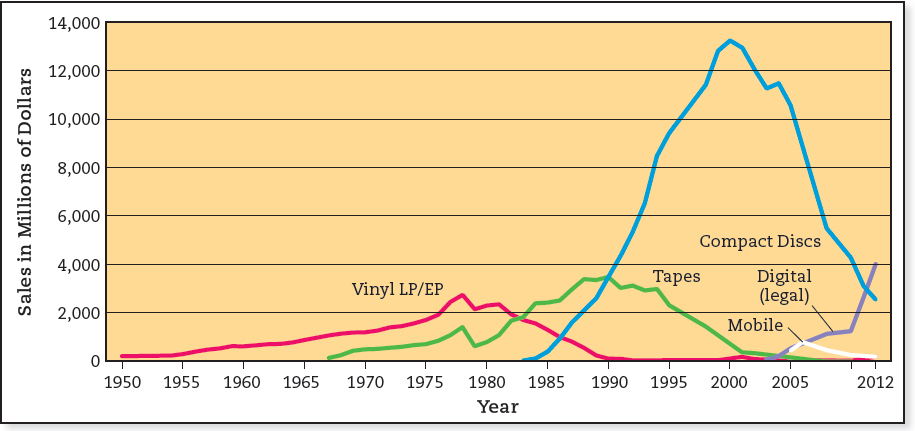The Rocky Relationship between Records and Radio
“Music should never be harmless.”
ROBBIE ROBERTSON, THE BAND
VideoCentral Mass Communication  bedfordstmartins.com/mediaculture
bedfordstmartins.com/mediaculture

Recording Music Today
Composer Scott Dugdale discusses technological innovations in music recording.
Discussion:
What about the way the video showed a song being produced surprised you the most, and why?
The recording industry and radio have always been closely linked. Although they work almost in unison now, in the beginning they had a tumultuous relationship. Radio’s very existence sparked the first battle. By 1915, the phonograph had become a popular form of entertainment. The recording industry sold thirty million records that year, and by the end of the decade sales more than tripled each year. In 1924, though, record sales dropped to only half of what they had been the previous year. Why? Because radio had arrived as a competing mass medium, providing free entertainment over the airwaves, independent of the recording industry.

Source: Recording Industry Association of America, 2012 year-end statistics.
Note: “Digital” includes singles, albums, music videos, and kiosk sales. Cassette tapes fell under $1 million in sales in 2008.
The battle heated up when, to the alarm of the recording industry, radio stations began broadcasting recorded music without compensating the music industry. The American Society of Composers, Authors, and Publishers (ASCAP), founded in 1914 to collect copyright fees for music publishers and writers, charged that radio was contributing to plummeting sales of records and sheet music. By 1925, ASCAP established music rights fees for radio, charging stations between $250 and $2,500 a week to play recorded music—and causing many stations to leave the air.
But other stations countered by establishing their own live, in-house orchestras, disseminating “free” music to listeners. This time, the recording industry could do nothing, as original radio music did not infringe on any copyrights. Throughout the late 1920s and 1930s, record and phonograph sales continued to fall, although the recording industry got a small boost when Prohibition ended in 1933 and record-playing jukeboxes became the standard musical entertainment in neighborhood taverns.
The recording and radio industries only began to cooperate with each other after television became popular in the early 1950s. Television pilfered radio’s variety shows, crime dramas, and comedy programs and, along with those formats, much of its advertising revenue and audience. Seeking to reinvent itself, radio turned to the record industry, and this time both industries greatly benefited from radio’s new “hit songs” format. The alliance between the recording industry and radio was aided enormously by rock and roll music, which was just emerging in the 1950s. Rock created an enduring consumer youth market for sound recordings and provided much-needed new content for radio precisely when television made it seem like an obsolete medium.
After the digital turn, that mutually beneficial arrangement between the recording and radio industries began to fray. While Internet streaming radio stations were being required to pay royalties to music companies when they played their songs, radio stations still got to play music royalty-free over the air. In 2012, Clear Channel, the largest radio station chain in the United States and one of the largest music streaming companies, with more than a thousand live stations on iHeartRadio.com, was the first company to strike a new deal with the recording industry. Clear Channel pledged to pay royalties to Big Machine Label Group—one of the country’s largest independent labels—for broadcasting the songs of its artists (including Taylor Swift, Tim McGraw, and The Band Perry) in exchange for a limit on royalties it must pay for streaming those artists’ music. With the agreement, Big Machine Label Group gained a new source of royalty income, and Clear Channel crafted a more stable future for its growing digital streaming operations.